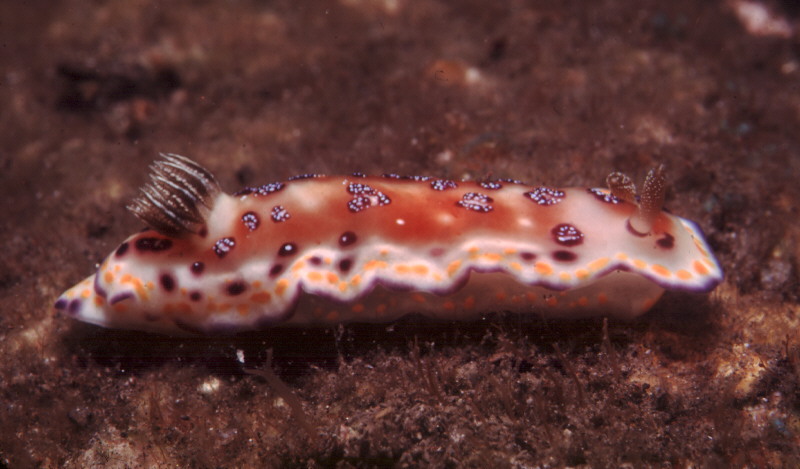 |
Chromodoris collingwoodi
One of the real crown princes of the family Chromodorididae is this week's featured nudibranch - Chromodoris collingwoodi. Our webmaster, Senor Miller, came across this specimen at Tulamben, Bali, Indonesia. This species is a large chromodorid, up to 10 cm in length. It was originally described by Bill Rudman from Australia, where most of the current sightings are from, but it is also known from New Caledonia.
The body coloration is splendid and complicated to describe. The mantle has a purple border, inside of which is a broad white region surrounding a large central translucent reddish or orange-brown patch extending from in front of the rhinophores to just behind the gills. To fully appreciate the variation in this species, compare Mike's photos here with the magnificent shot taken by Fred Bavendam, also from Indonesia, to be found at the top of page 207, in Debelius' Nudibranchs and Sea Snails . The adjoining photo on that same page from the Great Barrier Reef is misidentified however, so please do not be confused.
Chromodoris collingwoodi has many bright yellow spots scattered over the outer half of the white region, interspersed with dark purple spots. These latter dark spots are found not only in the white region but also in the central region where they are sometimes obscured by the darker mantle pigmentation.
One important differentiating characteristic is the scattering of fine white specks all over of the central brown region. The white specks are most noticeable where they concentrated over the dark purple spots.
The stalk of the rhinophore is translucent and the club is a dark reddish brown with white specks along the edge of the lamellae and a white tip. The gills are translucent with a dark brown, almost black, line down the two edges of each of the outer and inner sides.
Chromodoris collingwoodi has been confused with Chromodoris aureopurpurea as reported on Bill Rudman's Sea Slug Forum, but the latter differs in that its mantle is white with yellow spots, except at the edge, where there is a submarginal row of dark purple spots and a diffuse purple band right at the edge. As Rudman points out, "C. collingwoodi has an irregular purple border and then a broad region in which there are small yellow and larger purple spots. The central part of the mantle is usually a translucent red- brown with brownish spots and fine white specks."
Little is know about the biology of this species, but recent observations
by fellow Brancher/photographer Mary Jane Adams, suggests the species feeds
upon a black encrusting sponge.
Danville, Calif
March 2001
Taxonomic information courtesy of Dave Behrens

David W. Behrens
Author:
Pacific Coast Nudibranchs
Send Dave mail at seachalleng@earthlink.net
|
